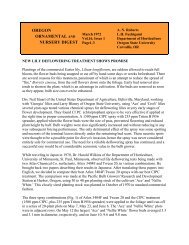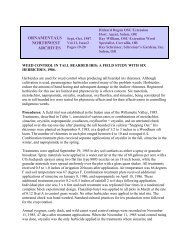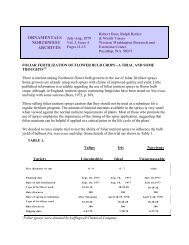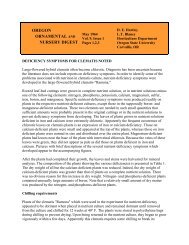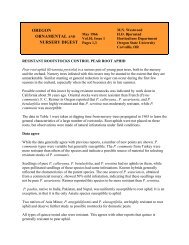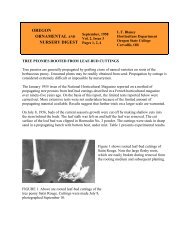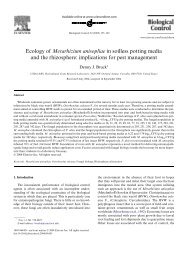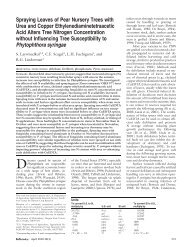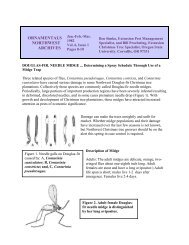Tomato Spotted Wilt Virus in Greenhouse Crops - Oregon State ...
Tomato Spotted Wilt Virus in Greenhouse Crops - Oregon State ...
Tomato Spotted Wilt Virus in Greenhouse Crops - Oregon State ...
You also want an ePaper? Increase the reach of your titles
YUMPU automatically turns print PDFs into web optimized ePapers that Google loves.
ORNAMENTALSNORTHWESTARCHIVESMay-June 1988Vol.12, Issue 3Page 10Jim Green, Horticulture Extension SpecialistNursery and <strong>Greenhouse</strong> <strong>Crops</strong><strong>Oregon</strong> <strong>State</strong> University,Corvallis, OR 97331TOMATO SPOTTED WILT VIRUS IN GREENHOUSE CROPSS<strong>in</strong>ce the report on the tomato spotted wilt virus <strong>in</strong> the Fall 1986 issue of the OrnamentalsNorthwest Newsletter (Green, 1986), severe losses of greenhouse crops have been reported <strong>in</strong> theUnited <strong>State</strong>s and Canada. The tomato spotted wilt virus has the widest host range of any virus(Francki and Hatta, 1981). It has been reported <strong>in</strong> 166 species of 34 families of cultivated plantsand weeds. Species with<strong>in</strong> the families Solanaceae, Compositae, and Legum<strong>in</strong>osae account forover one hundred of the recorded hosts. Some of the hosts are perennials and probably play animportant role <strong>in</strong> virus survival from year to year.Hosts of tomato spotted wilt virus (TSWV): Flower<strong>in</strong>g greenhouse plants on which the tomatospotted wilt virus has been reported <strong>in</strong>clude African violet, amaryllis, anemone, aster (dead tanareas <strong>in</strong> leaves, brown surface blotches on stems), baby's breath, begonia, bellflower, calceolaria,calendula, calla lily (whitish, then brown spots and streaks), Ch<strong>in</strong>a aster, chrysanthemum,c<strong>in</strong>eraria, columb<strong>in</strong>e, coreopsis, cosmos, cyclamen, dahlia, delph<strong>in</strong>ium, dusty miller, even<strong>in</strong>gprimrose, exacum, forget-me-not, fuchsia, gaillardia, geranium, gladiolus, glox<strong>in</strong>ia, hydrangea(r<strong>in</strong>g spot symptoms), impatiens, lobelia, marigold, morn<strong>in</strong>g-glory, nasturtium, peony, petunia,phlox, poppy, primula, ranunculus, salvia, snapdragon, stephanotis, stock, sweet pea, tiger lily,Transvaal daisy, verbena, and z<strong>in</strong>nia.Weed hosts of tomato spotted wilt virus <strong>in</strong>clude: Amaranthus spp., beggar ticks, b<strong>in</strong>dweed, bullthistle, Capsella sp., chickweed, clover, Conyza bonariensis, coreopsis, Crepis spp., datura,Emilia sp., Gaillardia sp., godetia, lup<strong>in</strong>, malva, mesembryanthemum, Montia sp., nightshades,Physalis sp., poppy, saxifrage, sow thistle, wild tobacco.TSWV can also occur on a wide range of non-ornamental crops such as broad bean, cauliflower,celery, chicory, coriander, copea, eggplant, endive, lettuce, papaya, peanuts, peas, peppers,p<strong>in</strong>eapple, snap bean, sp<strong>in</strong>ach, tobacco, tomato.Transmission of TSWV: Seed transmission of tomato spotted wilt virus through 96% of theseeds of C<strong>in</strong>eraria and tomato has been reported (Ie, 1970); the virus is apparently carried <strong>in</strong> thetesta, not <strong>in</strong> the embryo. Insect transmission: The only reported <strong>in</strong>sect vectors are four thripsspecies - Thrips tabaci, Frankl<strong>in</strong>iella fusca, Frankl<strong>in</strong>iella occidentalis, and Frankl<strong>in</strong>iellaschultzei.The virus is acquired from <strong>in</strong>fected plants by the thrips larvae when feed<strong>in</strong>g, but not by theadults. Only adults, however, transmit the virus to plants. Thus transmission is only by adults
that fed on <strong>in</strong>fected plants dur<strong>in</strong>g their larval stage. Thrips can reta<strong>in</strong> the virus for life, but theydo not transmit virus to their progeny. TSWV appears to be the only virus transmitted by thrips(Francki and Hatta, 1981).Control of TSWV: There is no cure for TSWV. The current control recommendations are torogue out <strong>in</strong>fected plants and to control thrips.REFERENCESAllen, T.C., J.P. McMorran, and E A. Locatelli. 1983. Isolation of tomato spotted wilt virus fromhydrangea and four weed species. Plant Disease 67:429-431.Francki, R.I.B. and T. Hatta. 1981. <strong>Tomato</strong> spotted wilt virus. Chapter 17, pages 492-511. In:Handbook of Plant <strong>Virus</strong> Infections and Comparative Diagnosis. E. Kurstak, editor.Elsevier/North-Holland Biomedical Press. 943 pp.Green, J.L. 1986. <strong>Tomato</strong> spotted wilt virus transmitted by Western Flower Thrips. OrnamentalsNorthwest Newsletter 10-2:8-9, Fall 1986.Ie, T.S. 1970. <strong>Tomato</strong> spotted wilt virus. In: Descriptions of Plant <strong>Virus</strong>es No. 39, October 1970.Issued jo<strong>in</strong>tly by the Commonwealth Mycological Institute (CMI) and the Association ofApplied Biologists (AAB), Kew, Surrey, England.Westcott, C. 1979. Westcott's Plant Disease Handbook. Fourth Edition revised by R. KennethHorst. Van Nostrand Re<strong>in</strong>hold Co. 803 pages. §Pesticide Use - Due to constantly chang<strong>in</strong>g laws and regulations, no liability for the suggested use of chemicals <strong>in</strong>this Newsletter is assumed by the ONW Newsletter. Pesticides should be applied accord<strong>in</strong>g to label directions on thepesticide conta<strong>in</strong>er.Permission to Repr<strong>in</strong>t material appear<strong>in</strong>g <strong>in</strong> the ONW Newsletter is granted with the request that you credit thesource: Ornamentals Northwest Newsletter, date, volume, issue, page numbers. Do not excerpt or repr<strong>in</strong>t <strong>in</strong> such amanner as to imply the author's endorsement or criticism of a product or concept.Nondiscrim<strong>in</strong>ation - The <strong>in</strong>formation <strong>in</strong> the Ornamentals Northwest Newsletter is provided with the understand<strong>in</strong>gthat no discrim<strong>in</strong>ation is <strong>in</strong>tended and that list<strong>in</strong>g of commercial products implies no endorsement by the authors.Criticism of products or equipment is neither <strong>in</strong>tended nor implied.





